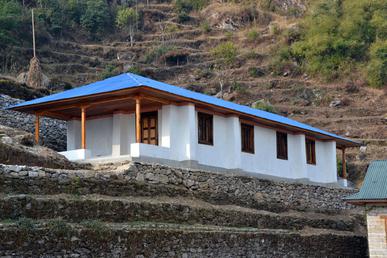

Earthbag construction is an inexpensive building method using mostly local soil to create structures which are both strong and can be quickly built. It is a natural building technique developed from historic military bunker construction techniques and temporary flood-control dike building methods. The technique requires very basic construction materials: sturdy sacks filled with organic material usually available on site.
Standard earthbag fill material has internal stability. Either moist subsoil that contains enough clay to become cohesive when tamped, or a water-resistant angular gravel or crushed volcanic rock is used. Walls are gradually built up by laying the bags in courses—forming a staggered pattern similar to bricklaying.
The walls can be curved or straight, domed with earth or topped with conventional roofs. Curved walls provide good lateral stability, forming round rooms and/or domed ceilings like an igloo. The structure is typically finished with plaster, either cement stucco on a strong mesh layer or an adobe or lime plaster, to shed water and prevent fabric UV damage.
Earthbag construction uses very little energy compared to other durable construction methods. Unlike concrete, brick or wood, no energy is needed to produce the earthen fill other than gathering soil. If on-site soil is used, little energy is needed for transportation. Unlike rammed earth construction, only human labor energy is required to tamp the soil lightly. The energy-intensive materials that are used – plastic (for bags & twine), steel wire, and perhaps the outer shell of plaster or stucco – are used in relatively small quantities compared to other types of construction, often totaling less than 5% of the building materials. Buildings last a long time when maintained. However, if "raw" or unstabilized soil is used as fill, when the building is no longer useful the earthen fill can be recycled into either garden areas, backfill, or new earthen buildings.
Earthbag building techniques were also explored in Sri Lanka after the 2004 tsunami.[20] Multiple earthbag construction projects have been completed in Haiti, most of these after the earthquake.[21] First Steps Himalaya[22] and other charities had built more than 50 earthbag buildings in Nepal prior to the April 2015 earthquake. Since then, local builders flocked to ongoing earthbag training opportunities, including those by Good Earth Global, which have led to official Nepal building code acceptance of this technique for residences. International NPOs have built hundreds of contained earth or earthbag buildings in Nepal as well, more residences than larger clinics or schools. NPOs are asking for more structural information to be better able to choose reinforcement types and intensity appropriate to local soil strength and seismic risk. University testing has begun but more is needed.